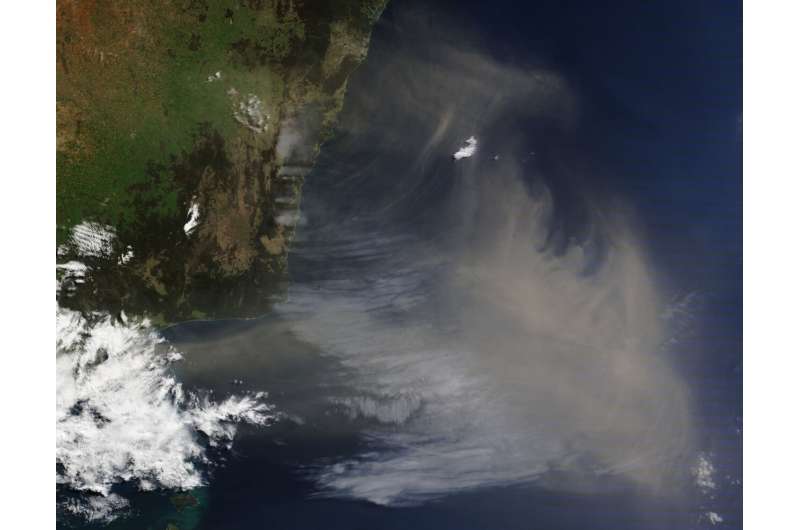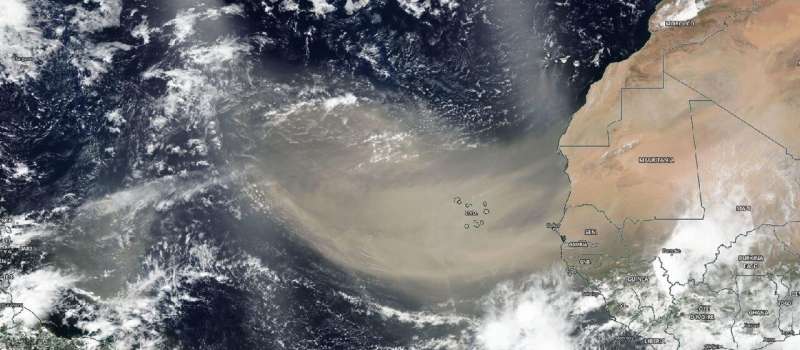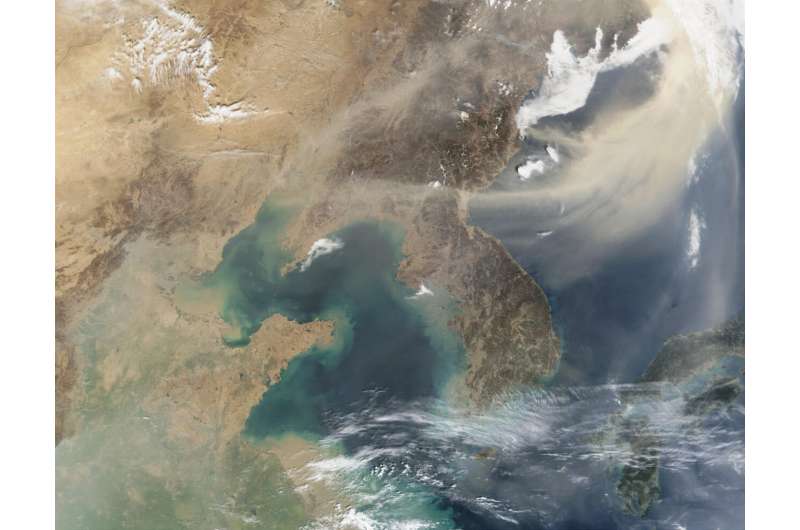This article has been reviewed according to Science X's editorial process and policies. Editors have highlighted the following attributes while ensuring the content's credibility:
fact-checked
peer-reviewed publication
trusted source
proofread
Scientists begin to unravel global role of atmospheric dust in nourishing oceans

New research led by an Oregon State University scientist begins to unravel the role dust plays in nourishing global ocean ecosystems while helping regulate atmospheric carbon dioxide levels.
Researchers have long known that phytoplankton, which are plantlike organisms that live in the upper part of the ocean and are the foundation of the marine food web, rely on dust from land-based sources for key nutrients. But the extent and magnitude of the impact of the dust, which consists of particles from sources such as soil that are lifted by the wind and impact the Earth's climate, have been difficult to estimate globally.
"This is really the first time it has been shown, using the modern observational record and at the global scale, that the nutrients carried by dust being deposited on the ocean are creating a response in the surface ocean biology," said Toby Westberry, an oceanographer at Oregon State and lead author of the paper published in Science on May 4.
The ocean plays an important role in the carbon cycle; carbon dioxide from the atmosphere dissolves in surface waters, where phytoplankton turn the carbon into organic matter through photosynthesis. Some of the newly formed organic matter sinks from the surface ocean to the deep sea, where it is locked away, a pathway known as the biological pump.
In the new paper, Westberry and other scientists from Oregon State; University of Maryland, Baltimore County; and NASA Goddard Space Flight Center estimate deposition of dust supports 4.5% of the global annual export production, or sink, of carbon. Regional variation in this contribution can be much higher, approaching 20% to 40%, they found.
"That's important because it's a pathway to get carbon out of the atmosphere and down into the deep ocean," Westberry said. "The biological pump is one of the key controls on atmospheric carbon dioxide, which is a dominant factor driving global warming and climate change."

In the ocean, vital nutrients for phytoplankton growth are largely provided through the physical movement of those nutrients from deep waters up to the surface, a process known as mixing or upwelling. But some nutrients are also provided through atmospheric dust.
To date, the understanding of the response by natural marine ecosystems to atmospheric inputs has been limited to singularly large events, such as wildfires, volcanic eruptions and extreme dust storms. In fact, previous research by Westberry and others examined ecosystem responses following the 2008 eruption on Kasatochi Island in southwestern Alaska.
In the new paper, Westberry and Michael Behrenfeld, an Oregon State professor in the Department of Botany and Plant Pathology, along with scientists from UMBC and NASA built on this past research to look at phytoplankton response worldwide.
Westberry and Behrenfeld focused their efforts on using satellite data to examine changes in ocean color following dust inputs. Ocean color imagery is collected across the global ocean every day and reports changes in the abundance of phytoplankton and their overall health. For example, greener water generally corresponds to abundant and healthy phytoplankton populations, while bluer waters represent regions where phytoplankton are scarce and often undernourished.
The scientists at UMBC and NASA focused their efforts on modeling dust transport and deposition to the ocean surface.
"Determining how much dust is deposited into the ocean is hard, because much of the deposition occurs during rainstorms when satellites cannot see the dust. That is why we turned to a model," said UMBC's Lorraine Remer, research professor at the Goddard Earth Sciences Technology and Research Center II, a consortium led by UMBC. The UMBC team used observations to confirm a NASA global model before incorporating its results into the study.

Working together, the research team found that the response of phytoplankton to dust deposition varies based on location.
In low-latitude ocean regions, the signature of dust input is predominately seen as an improvement in phytoplankton health, but not abundance. In contrast, phytoplankton in higher-latitude waters often show improved health and increased abundance when dust is provided. This contrast reflects differing relationships between phytoplankton and the animals that eat them.
Lower latitude environments tend to be more stable, leading to a tight balance between phytoplankton growth and predation. Thus, when dust improves phytoplankton health, or growth rate, this new production is rapidly consumed and almost immediately transferred up the food chain.
At higher latitudes, the link between phytoplankton and their predators is weaker because of constantly changing environmental conditions. Accordingly, when dust stimulates phytoplankton growth, the predators are a step behind, and the phytoplankton populations exhibit both improved health and increased abundance.
The research team is continuing this research, bringing in improved modeling tools and preparing for more advanced satellite data from NASA's upcoming Plankton, Aerosol, Cloud, ocean Ecosystem (PACE) satellite mission, some of which will be collected by the UMBC-designed and -built HARP2 instrument.
"The current analysis demonstrates measurable ocean biological responses to an enormous dynamic range in atmospheric inputs," Westberry said. "We anticipate that, as the planet continues to warm, this link between the atmosphere and oceans will change."
More information: T. K. Westberry, Atmospheric nourishment of global ocean ecosystems, Science (2023). DOI: 10.1126/science.abq5252. www.science.org/doi/10.1126/science.abq5252
Journal information: Science
Provided by Oregon State University




















